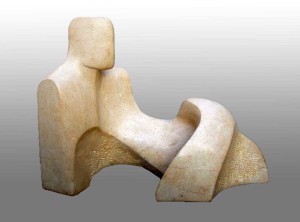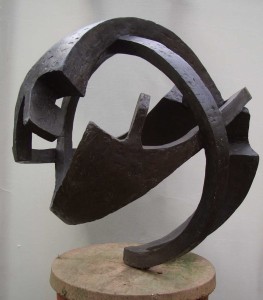Materials for Sculpture
Materials and Maintenance for Sculpture
In my work, I select the appropriate material in order to translate the design of my maquette to the final sculpture. It is essential that the materials for sculpture reflect not only the shape and aesthetic quality of the subject, but also the intended setting and site. Interior works are usually in stone or cast materials, whilst those for outdoor display are in cast materials but rarely stone.

A reclining figure in Ancaster Stone
Stone for Sculpture
Limestone and sandstone are selected for their unique qualities in order to enhance the particular sculptural forms. I use Ancaster limestone from Lincolnshire which has a soft creamy colour with darker subtle striations, and which looks well in many settings. Another favourite is soapstone from the only remaining quarry in Cornwall. It is dark with varying almost mottled shades of black, brown, iron and even very dark green, and is extremely heavy. Occasionally I will also use alabaster and other British stones and materials for my sculpture. I recommends that these stone sculptures are best kept indoors in order that they are not subjected to the effects of weather.
Stone Carvings are finished with a wax polish and should only need a light dusting.

‘Continuity’ cast in bronze resin
Cast Resin Materials for Sculpture
Most of my garden and larger sculptures are cast in bronze or aluminium resin. They are limited editions of no more than 12 per edition. A flexible rubber mould is taken from the original stone, clay, or polystyrene and plaster original. Then it is studio cast by a professional caster to simulate traditional materials using finely ground metals. These are combined with epoxy resin and reinforced with fibreglass to give a strong and durable sculpture. The result resembles foundry cast metal, but is lighter in weight and less expensive, making it more affordable for many clients. In recent years it has also been a popular choice by both private and corporate clients as it is less likely to be stolen just for its metal content.
Cast resins displayed indoors should simply be dusted whilst those in exterior settings may need occasional maintenance. Like my interior pieces they have had a wax polish applied and should be wiped with a damp cloth This removes general dirt and bird-droppings. Perhaps once a year an application of a good wax polish will help to restore the original condition.
Cast Metal Materials for Sculpture
Foundry cast bronze is the traditional material for sculpture. From the flexible rubber mould, a hollow wax impression is taken and molten metal poured. The sculpture is then subjected to a long process of grinding, polishing and sanding, It is then finished with chemicals to create the desired patination. This is known as the traditional ‘lost-wax’ method. Compared with cast resin, it is much heavier and more expensive, also needing specialist lifting equipment for large works of art.
Foundry cast metals displayed indoors will need a list dusting whilst the patination on exterior pieces will gradually weather, depending of the atmosphere of the site.
Patination of sculpture
This is a chemically induced colouring on cast sculpture which can simulate the effects of weather, ageing and atmosphere on metals. The colour can be to the client´s requirements provided a decision is made at the time of casting.
